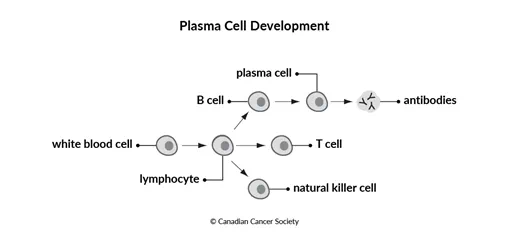What is multiple myeloma?
Multiple myeloma is a cancer that starts in plasma cells. Plasma cells are a type of white blood cell that makes antibodies (also called immunoglobulins) to help the body fight infection.
Plasma cells are found mainly in the bone marrow but are also in some other tissues and organs. Bone marrow is the soft, spongy tissue inside most bones where different types of blood cells are made.
Plasma cells in the bone marrow sometimes change and no longer grow or behave normally. These abnormal plasma cells (called myeloma cells) begin to divide uncontrollably and make more myeloma cells. Over time, the myeloma cells crowd out normal blood cells so they can't do their jobs. The myeloma cells can also cause bones to become weak. When the bones are weakened or damaged, 2 types of bone cells don't work together the way they usually do. Osteoblasts make bone and osteoclasts break down bone. Myeloma cells stimulate the osteoclasts to break down bone at a much quicker rate than normal.

Changes to the plasma cells can cause a precancerous condition called monoclonal gammopathy of undetermined significance (MGUS). Precancerous means that the cells are not yet cancer, but there is a higher chance they will become cancer.
In some cases, MGUS can progress to a plasma cell cancer. The most common type of plasma cell cancer is multiple myeloma. Other plasma cell cancers include solitary plasmacytoma and extramedullary plasmacytoma.
Plasma cell cancers can develop when there is a buildup of many myeloma cells in the bone marrow. Myeloma cells can form tumours in the bones (called plasmacytomas).
- Solitary plasmacytoma is when there is only one tumour in a bone.
- Multiple myeloma is when there are many tumours in the bones.
- Extramedullary plasmacytoma is when myeloma cells form tumours in soft tissues outside of the bones.
There are other conditions related to multiple myeloma including:
- POEMS syndrome
- Waldenstrom macroglobulinemia
- Light chain amyloidosis
- Plasma cell leukemia
- Heavy chain disease
The plasma cells
Types of multiple myeloma
Monoclonal gammopathy of undetermined significance
Conditions related to multiple myeloma
Your trusted source for accurate cancer information
With support from readers like you, we can continue to provide the highest quality cancer information for over 100 types of cancer.
We’re here to ensure easy access to accurate cancer information for you and the millions of people who visit this website every year. But we can’t do it alone.
Every donation helps fund reliable cancer information, compassionate support services and the most promising research. Please give today because every contribution counts. Thank you.
